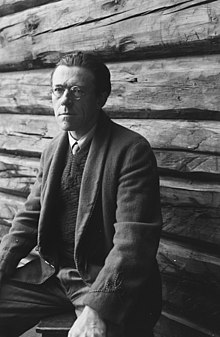
Back Peter Zapffe Afrikaans بيتر فيسل زابفه Arabic پيتير ويسيل زاپفى ARZ Peter Vessel Zapffe Azerbaijani Peter Wessel Zapffe Catalan Peter Wessel Zapffe Czech Peter Wessel Zapffe German Peter Wessel Zapffe Esperanto Peter Wessel Zapffe Spanish Peter Wessel Zapffe Estonian
Peter Wessel Zapffe | |
|---|---|
 Zapffe in 1949 | |
| Born | 18 December 1899 Tromsø, Norway |
| Died | 12 October 1990 (aged 90) Asker, Norway |
| Alma mater | University of Oslo |
| Occupation(s) | Philosopher, author, artist, lawyer, mountaineer |
| Notable work |
|
| Spouses | Bergliot Espolin Johnson
(m. 1935; div. 1941)Berit Riis Christensen
(m. 1952) |
| Awards | Fritt Ord Honorary Award (1987)[1] |
| Era | 20th-century philosophy |
| School | |
| Language | Norwegian |
Main interests | Metaphysics, nihilism, philosophical pessimism |
Notable ideas |
|
Preview warning: Page using Template:Infobox philosopher with unknown parameter "influences"
Preview warning: Page using Template:Infobox philosopher with unknown parameter "influenced"
Peter Wessel Zapffe (18 December 1899 – 12 October 1990) was a Norwegian philosopher, author, artist, lawyer and mountaineer. He is often noted for his philosophically pessimistic and fatalistic view of human existence.[2] His system of philosophy was inspired by the German philosopher Arthur Schopenhauer, as well as his firm advocacy of antinatalism.[3] His thoughts regarding the error of human life are presented in the essay "The Last Messiah" ("Den sidste Messias", 1933).[4] This essay is a shorter version of his best-known work, the philosophical treatise On the Tragic (Om det tragiske, 1941).[2]
- ^ a b Cite error: The named reference
biowas invoked but never defined (see the help page). - ^ a b Tangenes, Gisle R. (March–April 2004). "The View from Mount Zapffe". Philosophy Now. Retrieved 12 April 2020.
- ^ Zapffe remarked that children are brought into the world without consent or forethought: "In accordance with my conception of life, I have chosen not to bring children into the world. A coin is examined, and only after careful deliberation, given to a beggar, whereas a child is flung out into the cosmic brutality without hesitation." The Humorous Pessimist (1990 documentary, subtitled in English) by NRK, 32:18-32:44. Original source (in Norwegian).
- ^ Zapffe, P.W. (25 November 2016). "The Last Messiah". After us.